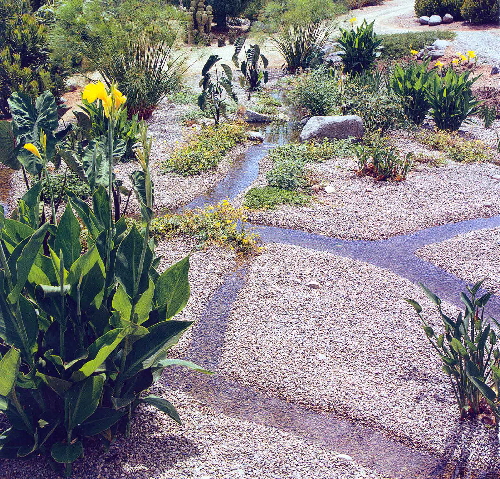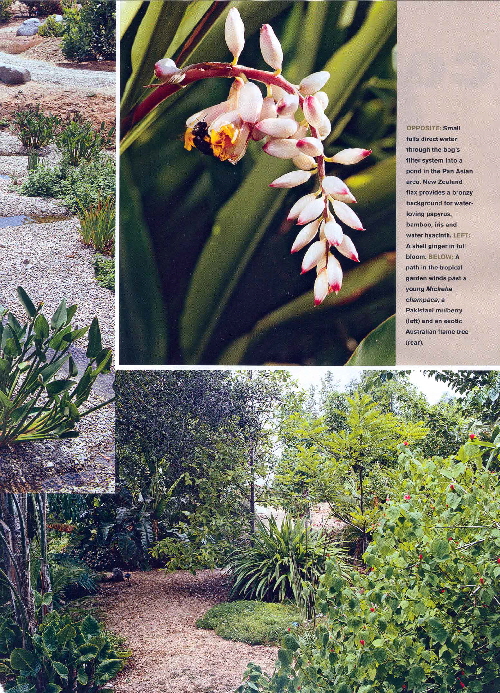
For each set of boulders, Morse first constructed a structural steel cage. Each cage is pumped full of concrete and shot with a concrete surface. A three-quarter-inch or thicker finish coat goes over the surface and is imprinted with latex molds that Morse makes from natural rock. Morse carves the surfaces to create cracks in the finish. Finally, he paints the surfaces with a special acrylic paint. The end product looks so real that one has to get up close to see that they are not true stone.

The higher elevation of the tropical jungle abuts the Childress home. In that area, the jungle is mostly rare and exotic ornamental trees and shrubs. Buddha tree (Ficus religiosa) and Zulu fig (Ficus nekbudu) are two of the more stately and unusual canopy trees. The air is perfumed with the fragrance of shell ginger, kahili ginger and plumeria that grow in the understory. There are 50 kinds of bamboos and as many palm varieties.
The path soon winds downhill through a large grove of tropical and subtropical fruits. The Childress' collection includes more than 20 guava varieties, a dozen kinds of mango, bananas, coffee trees, allspice, jujube, kiwi and passion vines. Grapes and figs, avocado and citrus cover the slopes, creating a veritable fruit feast for anyone passing by.
The largest of the garden's lagoons sits at the base of the slope. Covered with graceful water lilies, the 80-by 150-foot lagoon is fed by water that spills over a 10-foot-tall, vine-draped ledge. In his design, Morse created a small footpath and shallow cave behind the falls. There is enough room for someone to stand behind the water and look out through it. It is a magical spot, especially in the heat of the summer when mist from the falling water cools the air.
Morse and the Childresses intentionally over planted the tropical garden to give it the jungle feel they desired. Soon, it evolved into more than just a jungle - it became a tropical rain forest. As they scoured nurseries in search of the rare and unusual, Connie and Clyde became avid plant collectors.
Theme Gardens
Once the tropical garden was under way, the Childress’s considered the rest of their property. "We had the tropical garden," Connie says, "but we still had all this space to fill." The question was: What to fill it with?
Connie and Clyde came to their garden from very different approaches. Clyde had been a garden lover and observer. He had traveled the world during his career as a Marine pilot. He had visited South Africa where he was taken by the native landscape and the diversity of plants, largely those in the protea family.
In Japan, Clyde had visited formal gardens where he was fascinated by the way space was used. Japanese gardens made him realize that a garden is more than a collection of plants, it is a virtual "palette for the eyes." Clyde decided that he wanted to add a protea garden and a Japanese garden to the collection.
Connie had grown up gardening with her mother and grandmother. She was accustomed to digging and planting and getting dirty. Her goal was to have a nice rose garden.
Call: (760) 505-7900 Email: bryan@expandinghorizons.biz
© 2018 Expanding Horizons is a part of the Omni Pragma® family All rights reserved.

